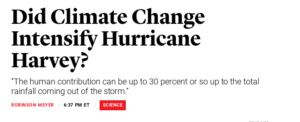
By ROBINSON MEYER
Every so often, the worst-case scenario comes to pass.
As of Sunday afternoon, the remnants of Hurricane Harvey seem likely to exceed the worst forecasts that preceded the storm. The entire Houston metropolitan region is flooding: Interstates are under feet of water, local authorities have asked boat owners to join rescue efforts, and most of the streams and rivers near the city are in flood stage.
Some models suggest that the storm will linger over the area until Wednesday night, dumping 50 inches of water in total on Houston and the surrounding area.
“Local rainfall amounts of 50 inches would exceed any previous Texas rainfall record. The breadth and intensity of this rainfall are beyond anything experienced before,” said a statement from the National Weather Service. “Catastrophic flooding is now underway and expected to continue for several days. ” (In years of weather reporting, I have never seen a statement this blunt and ominous.)
Climate scientists, who specialize in thinking about the Earth system as a whole, are often reticent to link any one weather event to global climate change. But they say that aspects of the case of Hurricane Harvey—and the recent history of tropical cyclones worldwide—suggest global warming is making a bad situation worse.
It may not be obvious why global warming has anything to do with hurricane strength. Climate change is caused by the release of greenhouse gases like carbon dioxide and methane into the atmosphere. These gases prevent some of the sun’s rays from bouncing back into space, trapping heat in the planetary system and raising air temperatures all over the world.
As the world warms, evaporation speeds up. So on avg there’s more water vapour for a storm to sweep up & dump now, compared to 70 years ago. https://twitter.com/ericholthaus/status/900507447957258240 …
This warmer air causes evaporation to happen faster, which can lead to more moisture in the atmosphere. But that phenomenon alone does not explain climate change’s effects on Harvey.
Storms like Harvey are helped by one of the consequences of climate change: As the air warms, some of that heat is absorbed by the ocean, which in turn raises the temperature of the sea’s upper layers.
“This is the main fuel for the storm,” says Kevin Trenberth, a senior scientist at the U.S. National Center for Atmospheric Research. “Although these storms occur naturally, the storm is apt to be more intense, maybe a bit bigger, longer-lasting, and with much heavier rainfalls [because of that ocean heat].”
This also suggests an explanation for one of Harvey’s strangest and scariest behaviors. The storm intensified up until the moment of landfall, achieving category-four strength hours before it slammed into the Texas coast. This is not only rare for tropical cyclones in the western Gulf of Mexico: It may be unique. In the past 30 years of records, no storms west of Florida have intensified in the last 12 hours before landfall.
Why do storms normally weaken—and why didn’t Harvey? As mentioned above, hurricanes feed and grow on warm ocean surface waters. But as they grow, their strong winds often pick up seawater, churning the oceans and moving the warmest waters deep below the surface. The same winds also bring newer, colder water closer to the atmosphere, which usually serves to drain energy and weaken the storm.
All of this said, a storm like Harvey could have happened even if there was no climate change. Planning experts have long fretted over the possibility of a major hurricane striking Houston. Harvey is also a powerful hurricane forming in one of the most hurricane-friendly regions of the world at the peak of hurricane season. Storms similar to it would form in any climate.
But Trenberth says that the extra heat could make the storm more costly and more powerful, overpowering and eventually breaking local drainage systems.
“The human contribution can be up to 30 percent or so up to the total rainfall coming out of the storm,” he said. “It may have been a strong storm, and it may have caused a lot of problems anyway—but [human-caused climate change] amplifies the damage considerably.”
More generally, it’s still unclear what effect climate change is having on hurricane formation across the greater Atlantic Ocean. A draft version of a major U.S. government review of climate science due out later this year says there is “medium confidence” that human activities “have contributed to the observed upward trend in North Atlantic hurricane activity since the 1970s.”
Houston has been ground zero for super-damaging storms lately. It has seen four 100-year flooding events since the spring of 2015, according to the meteorologist Eric Holthaus. The city also sees more than 156 percent more heavy downpours than it did in the 1950s. Meanwhile, only one-sixth of its residents have federal flood insurance, though that program has struggled to adjust to the increased flooding risk associated with climate change.
Yet even compared to recent storms, Harvey is unprecedented—just the kind of weird weather that scientists expect to see more of as the planet warms. Harvey has already dumped more water on Harris County than Tropical Storm Allison, the area’s previous worst-ever flooding disaster in 2001, though it has only lasted half the time of that earlier storm.


